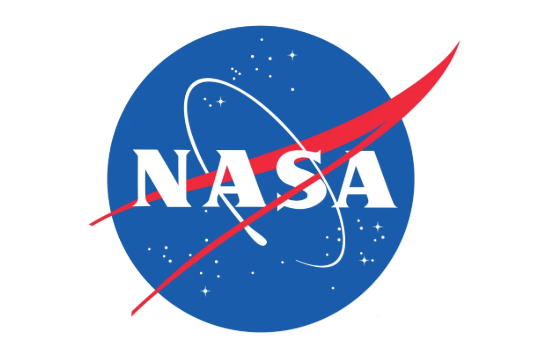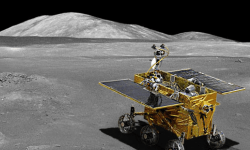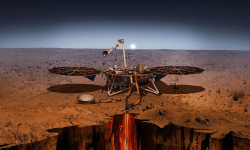
NASA has decided to validate a robotic mission to the Moon in 2022. A rover called VIPER will go thanks to the CLPS program, perhaps aboard a Blue Moon lander manufactured by Blue Origin. It will land at the South Pole of the Moon in order to identify and characterize the water ice that is present. It is indeed a very valuable resource in the context of the installation of an inhabited base.
The rover will drill to analyze how water ice and regolith are mixed. The mission should take place near a peak of eternal light, which will allow it to survive 100 days on the surface of the Moon. Again, the schedule is very short, 3 years to develop and launch a mission to another body of the solar system.

NASA supports the private space sector and space research through its Flight Opportunities program
– News of October 8, 2019 –
Between its future large telescopes, its space probes to send in all directions and the return of the Man on the Moon, the US space agency has a lot of work during the 2020s. In order to help them, NASA runs since 2010 a program called Flight Opportunities. This program is designed to enable companies and universities to test new technologies on sounding rockets, 0G aircrafts or sounding balloons. In nine years, nearly 200 technologies dedicated to space could be tested by avoiding the exorbitant costs of an orbiting. This process also allows for fast iteration development. It is much easier to put a prototype in a 0G aircraft, to analyze the data to improve the innovation, then to redo it on the same plane. This process takes a few weeks or months while the same orbital tests would take years. Of course, the technologies selected are part of NASA’s current and future plans.
On October 3, 2019, 25 new proposals were selected to join the program. They focus particularly on two topics : supporting the Artemis program (the American program for the return of humans to the Moon) and helping to commercialize the low orbit and the suborbital space. In the missions that will support the Artemis program, there is a lunar navigation and landing system, an automated sample collection system, an analysis and diagnostic solution for astronaut health, deployment of large solar panels inspired by origamis, or a device to improve the transfer of propellants in 0G. Among the missions that aim to lower the cost of the access to low orbit, there is research on “chipsats”, a new satellite format the size of a small biscuit. There is also a forecast system for atmospheric turbulences or an experiment for the synthesis of pharmaceutical products in orbit.
All of this research may not lead to a spacecraft, a space mission or an operational product, but NASA makes sure that it has some cards in its sleeves if the need arises. The most promising research may eventually be tested aboard the International Space Station. This program is also a great way to support the private suborbital flight industry. Many of these experiments are expected to fly on Blue Origin’s New Shepard rocket and on Virgin Galactic’s SpaceShipTwo spacecraft. These will probably be unmanned flights, but suborbital manned flights for research projects will then be scheduled.
The Italian Air Force has just become the first in the world to book a commercial suborbital flight with crew, to conduct research. Maybe this first flight will take place next year. Three researchers will embark with their experience aboard a SpaceShipTwo spacecraft. Unfortunately, they will not have time to rave about the spectacle of Earth from space because the precious minutes they will spend in microgravity will be used to conduct experiments on human biology and the chemistry of new propellants. NASA might be tempted to follow the Italian example rather quickly, whether with Blue Origin or with Virgin Galactic. And maybe within a few years, suborbital flights to do research will be common.
The US Senate has approved the 2020 NASA’s budget, much of which is allocated to the Artemis program
– News of September 29, 2019 –
The launch of the Artemis program in 2020 is theoretically still possible, although it seems more likely that this will take place in 2021. Earlier in the year, Jim Bridenstine had discussed the possibility of canceling a crucial test called Green Run, which would have saved up to six months on the calendar. For security reasons, the Green Run will actually take place. During this test, the four SLS central stage RS-25 engines will be fired for eight minutes, which will simulate a take-off for a lunar mission.
Even though the schedule is already behind schedule, NASA is giving the Artemis program a real budgetary reality. The US Senate has just approved a budget of 22.75 billion dollars in 2020 for NASA, up 1.25 billion from 2019, which was already a very good year. If we dissect this budget, the SLS receives $ 2.6 billion, the Orion spaceship receives $ 1.4 billion and the famous descent and ascent module that misses so much receives a first envelope of $ 750 million. NASA has all the keys to get things done, maybe not as fast as Donald Trump would like but we still look in the right direction.
On the eve of this budget announcement, the US Space Agency has reached an agreement with Lockheed Martin for the production of the Orion spaceship. The agreement also provides for an option on six additional Orion spaceships. The first three spaceships are to support Artemis missions 3, 4 and 5. They were ordered for $ 2.7 billion. In other words, we are pretty sure to see at least half a dozen missions with the Orion spaceship in the 2020s, and potentially up to twice as many.
In order to reduce costs, NASA and Lockheed Martin have agreed to put some form of recovery in place. Some Artemis 2 interior elements such as seats or electronic systems will be retrieved for the Artemis 5 mission. We will move up a gear with Artemis 6 which should fully reuse the Artemis 3 capsule. Despite these measures, the Artemis program material is very expensive. At nearly a billion dollars by lunar spaceship and more or less another billion per launcher, just going for a walk around the Moon monopolizes the equivalent of the annual budget of CNES, the French space agency, excluding development costs. If NASA wants to go to the Moon to stay there, it will have to find other ways to significantly lower its prices.
Winners and losers of NASA’s 2020 budget
– News of March 12, 2019 –
NASA’s budget proposal for 2020 is interesting. The budget is $ 21.02 billion, which is a very slight decline from what was achieved in 2019. However, it still exceeds all the budgets that NASA has received since the mid-1990s, adjusted for inflation. NASA is on a good budget momentum. But in this budget proposal, there are winners and losers.
On the losing side, there is WFIRST. The budget proposal for 2020 does not include any budget line for the future large telescope. We already known that the Trump administration is not in favor of allocating a budget for this project. WFIRST is nevertheless considered a scientific priority for the vast majority of astronomers. We imagine that they will fight to keep it in the final budget.
The other big loser is the SLS. The utility of NASA’s future heavy launcher is drastically reduced.
Two other Earth observation missions have also been canceled.
On the winning side, NASA reaffirms its support for James Webb. No cancellations are planned for the space telescope.
$ 363 million is allocated for the development of a high-capacity lunar lander. We know that NASA has asked its industrial partners to work on such a project in recent weeks. He now has his own budget line.
NASA has finally decided to limit the use of the SLS. The budget dedicated to the launcher is down sharply. That’s what makes it possible to finance research and development on the LOP-G or the lunar lander. Falcon Heavy, New Glenn and Vulkan will now have to share the missions abandoned by the SLS.
This is only a budget proposal that will be debated. We imagine for example that WFIRST will not flow without fighting. Hopefully, NASA may have the surprise of a larger budget than requested, as in 2019.
NASA’s 2019 budgets prepare transition of ISS to the private sector
– News of February 14, 2018 –
The 2019 budget proposal for NASA envisages a disengagement of ISS funding in 2025. After that, the idea is to let private companies take over, so that NASA can focus on the Moon. It is not only the ISS that suffers from the new lunar ambitions of NASA. NASA’s next big space telescope, WFIRST, should be abandoned along with five Earth observation missions.
NASA will certainly have a budget slightly higher than requested for 2019, that is to say $ 19.9 billion. Beginning next year, this budget provides $ 150 million to prepare for the transition of the ISS to the private sector. Over the next five years, $ 900 million will be allocated to this transition. We imagine that the main companies that will benefit are Bigelow, Axiom Space, SpaceX, Boeing and Sierra Nevada.
Boeing, SpaceX, Sierra Nevada and Orbital ATK will have to seriously think about the after ISS, because after spending more than a decade to develop private access to the ISS, the US space administration will withdraw their reason to be, while they are just entering the market. Let’s hope that the transition to private space stations will actually happen, otherwise the US “New Space” industry may decline.
Trump administration designates the Moon as NASA’s top priority
– News of October 10, 2017 –
Last week, US President Donald Trump’s cabinet finally revealed what US space policy will be under its governance. In 2004, the Bush administration set a goal for NASA to revive the program of manned flights to the Moon in 2010. The Obama administration has set a goal for the US space agency to launch manned flights to asteroids, then to the planet Mars. On Oct. 5, Mike Pence, Donald Trump’s Vice President, announced that his administration will change plans again. NASA must target the Moon again. We have the feeling that the Republicans want to go to the Moon and the Democrats want to go to Mars. But neither side manages to be in the White House long enough to complete its space plans.
The Trump administration has therefore requested changes to NASA. The first is the organization of the American Space Agency, with the rehabilitation of the National Space Council, an administrative corps responsible for setting NASA’s guidelines. It was created in 1989 by George Bush and dismantled in 1993 by Bill Clinton. Fortunately, these new guidelines for NASA should not disrupt the current developments too much. The SLS, the Orion capsule and the LOP-G are adapted to these new lunar ambitions, especially that in the longer term Mike Pence specified that the Mars planet remains a goal. But he did not set a date or a specific program. On the other hand, the manned mission to an asteroid, which until last Thursday was the next big step, disappears completely from the NASA program. The Trump administration plans to send several missions to the lunar surface, at a high frequency. In a second step, NASA will have to set up a permanent base on the Moon.
This changes almost nothing for NASA’s short-term plans because the LOP-G was meant to be a starting point for lunar and martian missions. The US Space Agency can therefore continue to implement its plans without major changes to current programs. This is, of course, excellent news because space programs need very long-term visibility in order to have ambitious goals. NASA’s dependence on the US administration will certainly continue to generate program changes. This is one of the big advantages of private companies compared to national space agencies.
NASA can not afford to send the first men to Mars
– News from August 1, 2017 –
Bill Gerstenmaier announced in early July that NASA is not able to give a date for an inhabited flight to Mars. The US space agency simply does not have the financial means for the project. For an outside observer, this statement is not surprising because NASA has no plans for a Martian trip. But after years of declarations of intention and promises, the leaders of the American administration are facing the reality. What is more disturbing is that the whole NASA manned flight program seems to move slowly, because once we remove the Martian objective, it appears that the US program has not objective at all.
NASA has invested tens of billions to develop its new SLS heavy launcher and the Orion capsule designed for missions beyond low orbit. NASA would like to go beyond the low orbit but for the moment it has not communicated other objectives. Yet other market players are moving fast. The Chinese manned space program, for example, has a precise and dated schedule : first a space station in orbit, then manned missions to the Moon and a lunar base. For the Mars target, private companies like SpaceX have visions that span decades. NASA has long clung to the Martian dream but it seems to be lost in half-projects and hesitations that does not fit the reputation of the US space agency. Fortunately, NASA performs well in other areas, such as robotic exploration. But 10 years ago we were sure that the first man on Mars would wear NASA’s spacesuit, which is far less obvious today.
NASA funds 22 innovation projects
– News of April 18, 2017 –
NASA has provided funding for 22 advanced innovation projects to address future issues in space exploration. These are feasibility studies, concepts, analyzes.
These projects are unlikely to see the light of day, but it is nevertheless very interesting to see how the engineers manage to solve, even theoretically, the main problems of space exploration.
In these 22 projects, there are interstellar propulsion systems using nuclear fusion or the Mach effect, technologies for the terra-transformation of Mars or telescope concepts. A propulsion system using the Woodward effect will be able to do without propellant, allowing much lighter vessels to be sent into space.
The NASA study will therefore be divided into three phases: the creation of laboratory models capable of providing steady and constant thrust, the design of a power supply capable of controlling this motor, and finally prediction models for determine the maximum performance of such a means of propulsion.
NASA believes that such a means of propulsion, if it is demonstrated and developed, could open the doors of stellar systems between 5 and 9 light years from our sun.
Logo by National Aeronautics and Space Administration [Public domain], via Wikimedia Commons









